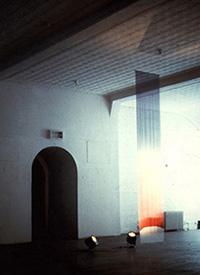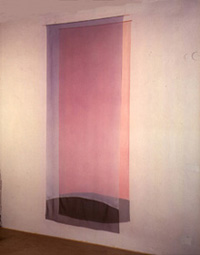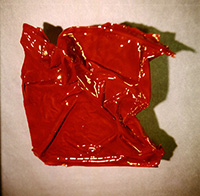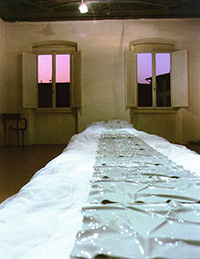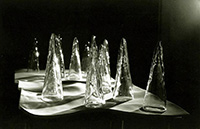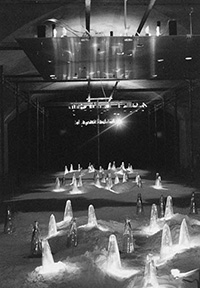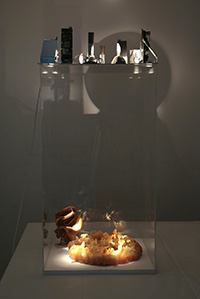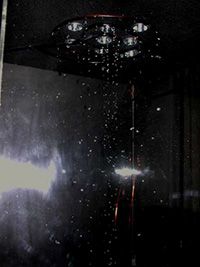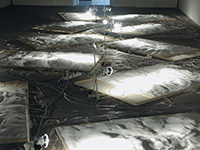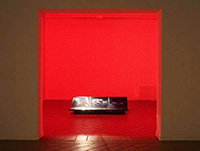Maria Novella Del Signore
From landscape to Landscape
The horizon of vision.
A territorial sphere exists, which could be defined as the border. It is a place where some artists at times, and this being the case of Maria Novella Del Signore, have set their creative space. All the ridges, the frontiers, the thresholds, and the partitions belong to the borders of contact between two realities. Exactly in the margin, the vision opens on two sides, because it is in a transit zone. It is osmotic, in which everything leaks out and everything passes through without coagulating into a stable and definitive shape. To remain in that sphere constitutes a daily balancing game which imposes elasticity and a lightness of being worthy of a juggler, whose experience is made on a fragile and fluid material. There, where one space ends and another one begins, is established a line of the horizon. However, although the horizon can be drawn and visibly perceptible, it is one of the segments of reality more elusive to be grasped and to be defined. The horizon is mobile, unreachable; it moves with our movement and our gaze. To set the horizon in an image is to set a temporary idea, this is why the first landscape of Maria Novella Del Signore is open to breathe the transitoriness in action as in Orizzonte (1972). This work presents the colors of dusk. The horizon and dusk are two states, permanent and mobile, in perpetual transformation, as if to say that one does not exist without the other, and it is between these two fluctuating borders that Maria Novella Del Signore “sets” her own area of artistic intervention. What springs forth from this gesture may be taken as a point of departure for a brief itinerary by way of the artist’s work and leads back to a primary choice in life. The “margin” becomes the only possibile place to set ourselves to watch the meetings of the changing currents that have their origins here. To seize, or better so, to let ourselves glide with the flow of these currents, is the recollection which is impossibile to avoid. Here we may intervene with a light touch, modelling this nothingness or better so, this “not yet”, to stop it in its auroral state of manifestation and offer it as hospitable territory for the other. This is the case of the passing of colors, an Aurora (1984) still a dusk, presented in the auditorium of P.S. 1 in New York. It is a long silk canvas suspended in the center of the room colored with an air brush and the chromatic range of a new morning. During the time span of four hours a light passes through and also a synchronized sound that varies from a minimum to a maximum intensity (exactly from 20 to 20000 Hz) and vice versa. Light and shadow, shadow and light alternate while never stopping along with the increasing and decreasing of the sound wave.
The only determined principle is the undetermined. Therefore, using color and air, color is a fluid material as is air, so how can they be united? Air is a veil of silk, a fog that is set and captured for a moment on a rigid support to be imbued with color, and then left to fluctuate in free counterpoint with another veil to create Volume (1981). The color deposited and stratified on the support paper carries out yet another voyage from which are born chromatic experiences close to the painting defined Ritagli. (date) Established are a myriad of collateral and synchronous micro-events that favor the slowing down and speeding up of the reading, in step and out of step, empty and full. They are inside the perimeter, which is limited by the visual field and defined by the area of the paper. The elaborations remain anchored to materials which are in themselves without shape. This is until the passage of the medium to ceramics stops in a moment the dynamics of the movement in Piega 1996, a new phenomenon giving structure to the shape. Once again another element is added to enrich the cognizance of the landscape we have attempted to define in these lines. Fine stagione (1996) is presented with a dim light in the large studio of the artist as a bed/river of soft folds. They are laid down on tulle which runs to the center of the room while laterally and almost apart, an iron table with high and thin legs supports a multitude of crystal cones with iridescent shadows. They create the atmosphere of a sidereal landscape. The work includes once again traces of sound, this time elaborated by Del Signore’s son Tommaso.
The element to be modelled still remains a fluid one, however, now the fluidness assumes the visual consistency of water, in which the movement is blocked in a state of glaciation, while another deeper source of water seems to continue to flow. In this way, Fluidi (1997) has been created. This new field of experimentation takes place in Marseille. It is conducted on thermo-forming iridal glass. The production process is very rapid and the quick gesture which models it is registered by the iridescent material.
In the choice of the operative process, it is possibile to read the heritage of an artistic culture which has since Surrealism adopted operative trial practices so as to reveal together with the individual mark, a joint structural conduct of the material utilized.
Maria Novella Del Signore draws much from these historical antecedents, as well as a knowledge of the most up to date scientific theories, filtered from the constant presence and an integrated support of her works by Giovanni Del Signore.
Even in the Dark was presented in June of 1999 in Florence at Sta Project. It was followed in autumn of the same year by the exhibition in London entitled, Two fields or more, which further gathers and expands the ideas and and the themes. Two large tables are the supports of two “Landscape” fields, on which conical hills of crystal stand out. They are the same ones which were elaborated on for the work in 1996. Here, the rigid geometry of each piece is “corrected” by hand. A quick touch opens the stillness closed by the form to return it to the uncertain and changing world, precisely the undetermined flow of life. Also changing are the borders of the luminous shadows which the little hills project on their surroundings in the marble dust. Parallel to this microcosm and suspended above as a protection there are two different technological territories made of lenses, mirrors, and electronic regulators which creater a sort of alter ego of the world below and in time they signal the superior limit of the border in which the landscapes of the conical hills are the lower limit. Once again the mysterious electronic sonority by Tommaso del Signore accompanies the works.
It is as if the first nucleus-seed of the work, after various vicissitudes and multiple metamorphoses, had succeeded in reaching the destination thought impossible to find, that land in the middle, home and origin of what exists and what is yet to come, where it put down roots before growing in new directions. Confirmation of this is provided by the construction Some Fields, and Strings (2003) in the Museo Marino Marini in Florence. The large installation (a completely modified version of the one in London) has been enriched with a new modular block and new metallic sounds from the strings developed by Tommaso Del Signore. Some Fields, and Strings occupies the whole of the museum’s crypt and, for this reason, could be defined as a monumental work, were it not for the fact that the formal mechanism is designed to focus attention on the clash of forces between the two superimposed planes: the upper one illuminating, rational, technological, scientific and focusing; the lower one intuitive, elusive, changeable, discontinuous and mutant.
Once that astonished, secret, mineral place, inhabited by an obscure luminous haze, had been reached, it was followed by these experiences: Some Bodies Memories (2006) at Villa Pacchiani in Santa Croce sull’Arno, and Animal Earth (2007) at the Galleria d’Arte Moderna e Contemporanea in San Gimignano. In Some Bodies Memories it is as if a space probe, sent to explore precisely that area traversed by charges of constrained energy, had brought back a group of finds that were then arranged in the rooms of a museum on the basis of a taxonomy that sees them as fragmentary because in progress. On display are various kinds of sheath-skins with waxy and glassy surfaces, interwoven in twists and turns, swollen by the pressure of underlying telluric spasms. At times the surfaces display a greenish opalescence generated by an endogenous light, at others they are animated from the outside by liquid acid-yellow lights: exhibits of a now petrified organism or, vice versa, of a mineral world that is dreaming, and prophesying, its own organic condition. In fact the first set of exhibits is accompanied by a second made up of blowups of dead lizards and photographs of the hands of a young female saint, along with an empty nest and a bumpy sweet potato, waving the plume of a green shoot. All together the “exhibits” allude in a patchy but for this very reason powerful way to the impossible form of a single body through which the movement of life flows incessantly, even where it is not recognizable as such. With Animal Earth, at the Galleria d’Arte Moderna in San Gimignano, visitors were no longer presented with the idea of an “exhibit” but, without any other intermediaries than their own perceptual faculties of sight and hearing, and their own movements, were brought into direct contact with the phenomenon of the spring, as if the artist wished to show the movements of matter as she has seen and found them. And so on the one hand they were drawn by the scent of molten wax that emanated from aluminum containers arranged in the secluded spaces of the gallery; while on the other they were induced to head off on a short stroll through the larger of the exhibition rooms because they were attracted by the series of “tubs” on the ground filled with white sand, the lunar color of calcium carbonate. Here they could hear the breath of the earth that rose and fell, at regular intervals, under the impetus of mechanical bradyseismic movements driven by pumps that controlled the hidden rubber lungs; and here they could remain for a long time watching the mobile topographies produced by the slippage of the loose material, wrinkling into desert canyons. Thus certain hints of crystallized forces previously made by the artist were revealed in this case as forces at work, exposed on the surface, as it were, to the light of the sun, or re-veiled; and so the secret of their being remains jealously guarded. It is like having seen in the distance, just for a moment, the blowing of a whale just before it plunged back into the deep.
Laura Vecere, Florence, September 5, 2009
